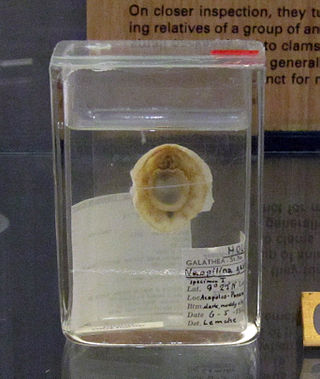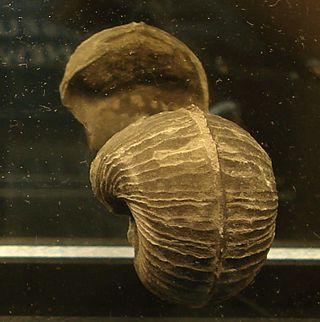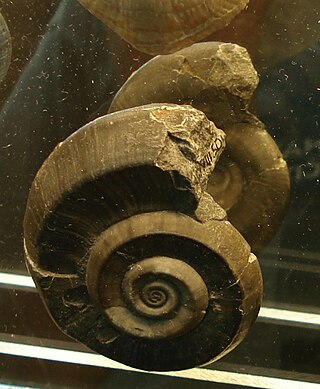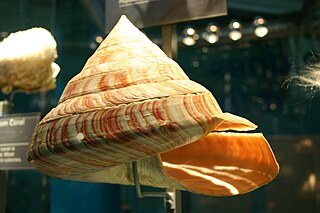
Gastropods, commonly known as slugs and snails, belong to a large taxonomic class of invertebrates within the phylum Mollusca called Gastropoda.

Monoplacophora, meaning "bearing one plate", is a polyphyletic superclass of molluscs with a cap-like shell inhabiting deep sea environments. Extant representatives were not recognized as such until 1952; previously they were known only from the fossil record, and were thought to have become extinct 375 million years ago.

Bellerophon is a genus of extinct paleozoic marine molluscs of uncertain position in the family Bellerophontidae.
Strepsodiscus is an extinct genus of very primitive fossil snail-like molluscs from the early part of the Late Cambrian of North America. The coiled, slightly asymmetrical shells are about 3 cm in height. It is not known whether these are shells of gastropods or monoplacophorans, which are more primitive mollusks.

The Bellerophontidae are an extinct family of specialized globose bellerophontids, Paleozoic and early Triassic mollusks of the class Gastropoda.

Latouchella is an extinct genus of marine invertebrate animal, that is considered to be a mollusk and which may be a sea snail, a gastropod. It is a helcionellid from the Tommotian epoch of what is now Siberia. Its tightly coiled, spiral shell contains a number of low "walls" running up the front surface of the interior; these would have directed water currents within its shell. Between these walls are a series of furrows, parallel to the shell's aperture, giving casts of the internal structure the appearance of a railway line, with sleepers tying together paired rails that run towards the apex of the shell.

The Euomphalina comprise a major suborder of mainly Paleozoic archaeogastropods, shells of which are hyperstophic to depressed orthstrophic, commonly with an angulation at the outer upper whorl surface thought to be coincident with the exhalent channel; shell wall thick, outer layer calcitic, inner layers aragonitic but not nacreous; operculum calcareous and heavy. Their range is from the Upper Cambrian to the Triassic, and possibly as high as the Upper Cretaceous.

Helcionellid or Helcionelliformes is an order of small fossil shells that are universally interpreted as molluscs, though no sources spell out why this taxonomic interpretation is preferred. These animals are first found about 540 to 530 million years ago in the late Nemakit-Daldynian age, which is the earliest part of the Cambrian period. A single species persisted to the Early Ordovician. These fossils are component of the small shelly fossils (SSF) assemblages.

Helcionelloida is an extinct group of ancient molluscs. These are the oldest known conchiferan molluscs, that is, they had a mineralised shell. Some members of this class were mistaken for Monoplacophorans. The class was erected by Peel in 1991.

Bellerophontoidea, common name "bellerophonts", is a superfamily of extinct planospirally-coiled globose molluscs. This superfamily is generally included within the Gastropoda, but may instead be a group of monoplacophorans. The taxon first appeared late in the Cambrian and continued until late in the Triassic.

Pleurotomarioidea is a superfamily of small to large marine gastropods included in the order Pleurotomariida of the subclass Vetigastropoda.
Bucanellidae is an extinct family of Paleozoic molluscs of uncertain position, belonging either to Gastropoda (snails) or Monoplacophora. The family lived from the upper Cambrian to middle Permian and the shells are characterized by a relatively small median sinus in the upper margin of the aperture, and collabral (transverse) or spiral (longitudinal) threads covering the shell. The shells are planispirally coiled rather than trochospirally with a spire as is the case with most shelled gastropods.
Bucaniidae is an extinct family of Paleozoic molluscs of uncertain position possibly being either gastropods or monoplacophorans in the superfamily Bellerophontoidea. The family lived from the Lower Ordovician to the Devonian and have shells in which the apertural margins tend to flare. Most genera have a slit and selenizone, others some modification of this feature.

Macluritidae is an extinct family of relatively large, Lower Ordovician to Devonian, macluritacean gastropods(?), hypserstrophically coiled, that is dextral while appearing sinistral, of which the genus Maclurites is arch-typical. The base of their shells is flat or gently protruding while the upper side is generally concave.
The †Raphistomatidae is a taxonomic family of fossil sea snails, Paleozoic marine gastropod mollusks. This family was established by Koken in 1896. This family is found in the fossil record from the Upper Cambrian to the Middle Permian.
†Onychochilidae is an extinct family of small, fossil, upper Cambrian to lower Devonian molluscs. They have hyperstrophically coiled shells which generally have smooth whorls and elongate apertures. They are commonly considered to be gastropods, i.e. sea snails.

Euomphaloidea, originally Euomphalacea, is an extinct superfamily of marine molluscs that lived from the Early Ordovician to the Late Cretaceous, included in the Gastropoda but speculated as instead perhaps Monoplacophora.
The Kirengellids are a group of problematic Cambrian fossil shells of marine organisms. The shells bear a number of paired muscle scars on the inner surface of the valve.

Rhynchonelliformea is a major subphylum and clade of brachiopods. It is roughly equivalent to the former class Articulata, which was used previously in brachiopod taxonomy up until the 1990s. These so-called articulated brachiopods have many anatomical differences relative to "inarticulate" brachiopods of the subphyla Linguliformea and Craniformea. Articulates have hard calcium carbonate shells with tongue-and-groove hinge articulations and separate sets of simple opening and closing muscles.
The Trochina is a taxon that is used by paleontologists. It is a suborder of primitive sea snails, marine gastropod mollusks.








